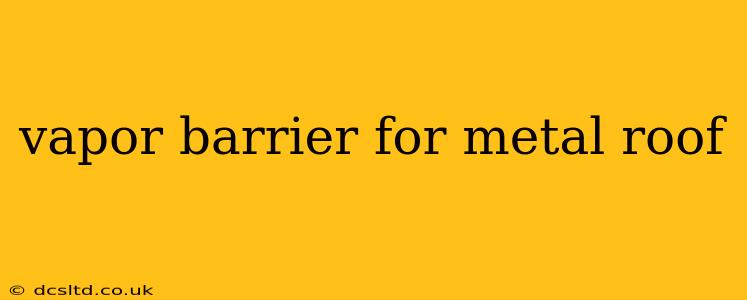Metal roofs are increasingly popular due to their durability, longevity, and low maintenance. However, a crucial aspect often overlooked is the importance of a proper vapor barrier. Understanding vapor barriers and their role in protecting your metal roof and the building's structure is key to preventing costly damage down the line. This comprehensive guide will delve into everything you need to know about vapor barriers for metal roofs, answering common questions and providing valuable insights.
What is a Vapor Barrier and Why is it Important for a Metal Roof?
A vapor barrier is a material designed to restrict the movement of water vapor. In the context of a metal roof, its primary function is to prevent moisture from entering the building's structure from inside. Moisture can originate from various sources like showering, cooking, and even breathing. This moisture, if not controlled, can condense within the roof assembly, leading to:
- Mold and mildew growth: Creating unhealthy living conditions and potentially damaging structural components.
- Wood rot and decay: Compromising the structural integrity of your roof and requiring costly repairs.
- Insulation degradation: Reducing the effectiveness of your insulation, leading to higher energy bills.
- Rust and corrosion: Damaging the metal roofing itself, shortening its lifespan.
Therefore, a properly installed vapor barrier is crucial for maintaining the longevity and performance of your metal roof and the overall health of your building.
What are the Different Types of Vapor Barriers Used for Metal Roofs?
Several materials can serve as effective vapor barriers. The best choice depends on factors like climate, budget, and building codes. Common options include:
- Polyethylene (PE) films: These are relatively inexpensive and readily available, but their durability and vapor resistance can vary.
- Polypropylene (PP) films: Often more durable and resistant to punctures than PE films.
- Reflective foil-faced insulation: Combines insulation with a vapor barrier, offering both thermal and moisture control.
- Specialty membranes: High-performance membranes offer superior vapor resistance and durability, but are typically more expensive.
How is a Vapor Barrier Installed on a Metal Roof?
Proper installation is crucial for a vapor barrier's effectiveness. The process generally involves:
- Preparation: Ensure the underlying roof deck is clean and free of debris.
- Installation: The vapor barrier is typically installed directly to the roof deck, overlapping seams and sealing them with appropriate tape. It's crucial to create a continuous, airtight seal.
- Fastening: Use appropriate fasteners to secure the vapor barrier in place without puncturing it excessively.
- Insulation: Install insulation over the vapor barrier.
- Metal Roofing Installation: Finally, install the metal roofing system.
Where Should the Vapor Barrier Be Placed in a Metal Roof System?
This is a critical question, and the answer depends heavily on your climate. In warmer, humid climates, the vapor barrier is generally placed inside the building, on the warm side of the insulation. This prevents moisture from the interior from penetrating the roof assembly. In colder climates, the placement might be less critical, as the risk of interior moisture buildup is lower. Always consult local building codes and a qualified roofing professional for guidance.
What Happens if a Vapor Barrier is Not Installed Properly?
Improper installation or the absence of a vapor barrier can lead to significant problems, including:
- Accelerated deterioration: Of the roof structure and components due to moisture damage.
- Increased energy costs: Due to compromised insulation performance.
- Health issues: Due to mold and mildew growth.
- Premature roof failure: Requiring costly and disruptive repairs or replacements.
Can You Use a Vapor Barrier with Any Type of Metal Roofing?
While vapor barriers are beneficial with most metal roofing systems, the specific requirements might vary slightly depending on the type of metal (e.g., steel, aluminum, copper). Always refer to the manufacturer's instructions for your specific roofing material.
How Much Does a Vapor Barrier for a Metal Roof Cost?
The cost varies significantly based on the type of vapor barrier, the size of the roof, and labor costs. It's always best to obtain quotes from several reputable roofing contractors to get a clear understanding of the expenses involved.
What are the benefits of using a vapor barrier on a metal roof?
The benefits extend beyond just preventing moisture damage. A correctly installed vapor barrier can contribute to a longer-lasting, more energy-efficient, and healthier building. The peace of mind knowing your roof is properly protected is invaluable.
This guide provides a solid foundation for understanding the importance of vapor barriers in metal roofing. Remember, consulting with experienced roofing professionals is crucial for ensuring the proper selection, installation, and ongoing maintenance of your vapor barrier system. Your investment in a properly protected roof will pay dividends in longevity and peace of mind.
